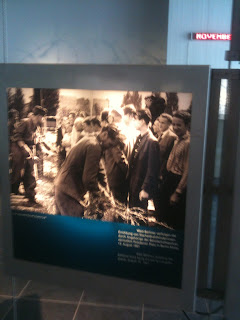Technically speaking, drinking on the train is verboten. In reality, everyone drinks on the train. People of all ages and social strata. Beer. Bottles of wine. It was surprisingly very much under control. It was still just around midnight - things might get crazier as the night progresses.
Berlin is very much a late night city.
Anyway, Sunday. We started with a nice breakfast at Schwarzwaldstuben. Cheeses, breads, fruit, jam, yogurt, etc. It was very nice.
We tried physalis. It looks like a tiny tomato and tastes a bit like a gooseberry. Here's what the leaves look like.
From here it was off to the memorial. Berlin is just teeming with graffiti - both interesting and banal. I'm filing this one under interesting.
The memorial starts with a visitors center. It is connected to an outdoor tower from which you can view the entire memorial along with a closed section of the wall that is as it was during the height of the cold war.
Our vantage point in these pictures is from the west looking to the east.
Construction began in 1961. Over the next 28 years it would be strengthened, modified, and redeveloped. Now with more death strips! What began as a barbed wire fence became a highly fortified concrete wall surrounding the entirety of West Berlin. The East claimed that the wall's purpose was to curb all western / fascist influence from disrupting the delicate new socialist utopia in the DDR. In reality it was built to stop East Germans from defecting to the west through West Berlin.
In the years leading up to the construction of the wall, 3.5M East Germans defected to the West. West Berlin was a natural jumping off point as it was by far the eastern-most point of western departure for any East Germans wishing to leave for the west. After the wall was built, around 5,000 attempted escape and approximately 600 died in the process.
Now I'm going to break away and pull out my virtual soapbox. I apologize, but I can't - in good conscience - talk about these things without addressing my feelings on the importance of these walks through history. Much of the historical aspect of this trip highlights two main points for me. One, man's astonishingly hideous inhumanity to man. Two, man's collective failure to learn from the horrors of the past. We keep doing the same things over and over again in the name of decency, freedom, exclusion, security, paranoia, and / or country. And when we do those things we forget about real decency, tolerance, and humanity. It depresses me. It makes me angry. </soapbox>
Okay, the wall memorial. Inside the visitors center is a great picture / news clipping / document center highlighting the construction of the wall, attempted escapes, and the political climate during the various periods of the cold war. It is fascinatingly complex and I can't even hope to try to explain the effects of world events on the construction of the Berlin Wall and the Cold War in general.
This is just such an amazing period of history. So many important intertwined events and actors. This trip actually makes me wish that I had taken more time to learn post World War II history. It's never too late!
Below is a picture of West Berliners watching - with smiles! - the construction of the first wall.
And here's Checkpoint Charlie with American tanks on one side and Soviet tanks on the other.
The "death strip" in this section of the wall has been transformed into the current memorial.
This death strip area was originally part of a cemetery. The East Germans removed the stones, and paved over and / or disposed of the bodies. Today there are several crosses commemorating these displaced graves.
Originally, the wall was actually interspersed with buildings in this area. When it was built, the windows and doors were bricked up. Like this.
There are pictures of the final moments with people jumping out of windows to escape. It's heartbreaking. Eventually the DDR destroyed most of these buildings in the successive redevelopment of the wall.
In 1985 the DDR destroyed the Versöhnungskirche, again in the name of security.
I'm going to close with another interesting aspect of life in post wall Berlin. Ghost stations. An odd quirk of the Wall is that there were U-bahn and S-bahn lines connecting various points in West Berlin that ran through small portions East Berlin. West Berliners could travel on these trains, but the trains did not stop in the East Berlin stations - except at Friedrichstraße where travelers could transfer from the U6 to another S-bahn line without leaving the station. The trains would slow down but not stop - there were heavily armed DDR guards standing at attention in very low light at each of the ghost stations.
West German rail maintenance had no access to the tracks in East Berlin. If a train broke down the passengers would have to wait for DDR guards to escort them back to West Berlin. Other tunnels were blocked, entrances were closed or disguised as guard boxes, and motion detectors were placed in the stations and tunnels.
As always, I'm sorry if there is any incorrect / missing info here. I am not a historian. These are also my thoughts and don't reflect those of anyone else other than me. Many of the pictures were taken by either Emily or I. The rest were snagged from the internet. Thanks to the following - non-Wiki - sources.
Next up; Collin, Emily, and Christoph visit the Computerspiele Museum.
















No comments:
Post a Comment